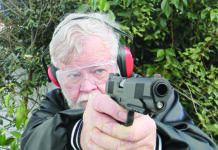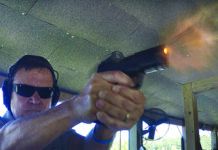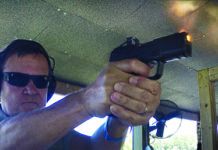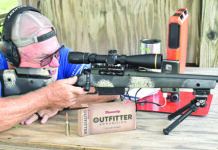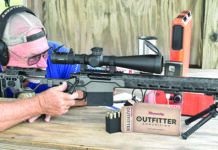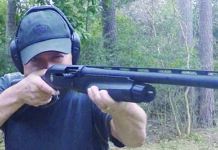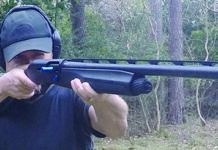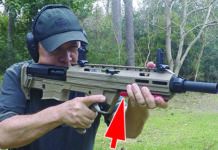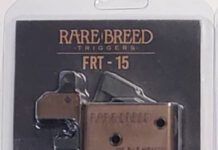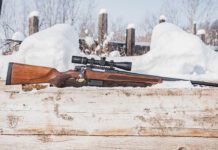In the world of 308 auto-loading rifles, the M14 and its look-alikes reign just about supreme. They have it all, looks, power, function, capacity, plus a great variety of stock and accessory configurations from wood to all manner of polymer that can convert an M14 or M1A into just about any configuration you might want, particularly if you have deep pockets. In this test we look at three wood-stocked versions, a remanufactured Chinese-actioned Polytech M14/S that was converted several years ago by Fulton Armory into a mostly GI-part rifle (about $1900), a new Fulton Armory M14 ($2755), and an M1A from Springfield Armory ($1739). The M14/S was fitted with a Burris 2-8X scope in an S&K mount, but the iron sights were still usable with the scope attached. We used both the scope and iron sights to test that rifle so you could see what one of these rifles can do, and used the irons on the other two.
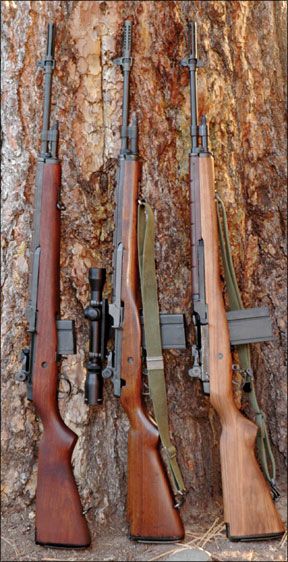
We tested with three types of ball ammunition, the only type recommended in these firearms. It was Federal Gold Medal match, Magtech 150-grain ball from Brazil, and mixed lot of recovered ammunition purchased in bulk with headstamps from Israel, Italy, Belgium, and Canada, which we used unsorted. Here’s what we found.
Polytech M14/S Customized 308 Win., about $1900
This rifle had its original Chinese action, which various sources have identified as one of the better actions available, and the only forged one. Receivers of the current Fulton and Springfield rifles are investment castings. The heat treatment of these Polytech actions is generally excellent, but if you have one and want to convert it, we suggest you contact Fulton Armory for an evaluation. This one was tested and considered to be the near equivalent of best U.S. forged actions, and thus ideal for conversion. The barrel is a chrome-lined Winchester in new condition. The bolt is a TRW, and most of the other parts are G.I. originals. The gas cylinder is a National Match one as is the front sight. The rear aperture is standard G.I. The Parkerizing is new on all the metal. The barrel cover is one of the somewhat rarer vented ones, still occasionally found at gun shows. The stock was put on by the owner. It’s a used, walnut, genuine G.I. one with scratches and wear from earlier use.
The trigger pull is so good as to be almost famous. There’s 3.5 pounds of smooth take-up to a stop, and then one more pound gives one of the cleanest breaks we’ve experienced. Putting great trigger pulls on M14s is one more area where Fulton’s Clint McKee excels. The rifle’s owner formerly had a genuine Brookfield mount on the rifle with a 10X Leupold Mil-Dot M4 sniper scope on it, but the mount and setup were too limited, he said, so he replaced them with the removable S&K base and the 2-8X Burris scope shown in the photos.

The stock felt great, and was much slimmer than those on the other two rifles. The wood had plenty of nicks and dings that had been preserved by the owner’s refinish job. A stock with some visible history was preferable to a brand-new look, he said.
The muzzle brake bears mention. It was made by drilling out the false slots in the original Polytech muzzle brake. This was then tested at night, the owner told us, and it showed exactly no flash in the night sky. It also had the effect of reducing recoil. We did not have the chance to test all three rifles at night for flash, but the other two had military-type flash hiders installed, and they have been tested extensively in actual use. Only the Fulton had the bayonet lug.
On the range we first shot the M14S with the scope and Federal Gold Medal target ammunition. The first three shots went into 0.6 inch at 100 yards. The next three measured 1.0 inch. We fired with the iron sights and got 1.2. The Magtech ammo did 1.3 inches with the scope and 2 inches with iron. The surplus ammo shot well enough too. We really liked the smoothness of this rifle, and preferred the feel of its worn but slim G.I. walnut stock to that of the other two. We also liked the look of the vented barrel guard.
If you have a Polytech and want to get it modified by Fulton, we suggest you contact them to see about the suitability of your action, and get some idea of the estimated costs. There may be issues with fitting a G.I. bolt to the Chinese receiver, or other issues with the suitability of some parts, and only an expert can advise you. The advantages would be having a forged receiver instead of a cast one, plus the benefit of careful hand fitting of new parts to your Chinese receiver. It’s your call, but if you go this way, we suspect you’ll be pleased with the result. However, for the approximate same cost you can buy a new M1A from Springfield, and that may be a better choice for you, not to mention easier to sell later. For example, some of the additions and fitting of the G.I. and NM parts that were done to our test gun would add well over $1200 to the cost of the basic rifle today, and we might have missed a few items.
Our Team Said: We came to like this rifle quite a lot. It didn’t look new like the other two, but it had it in spades where it counted.
Fulton Armory M14 308 Win., $2755
Other than an extremely attractive rifle with a gorgeous stock, what do you get for your money over the cost of the Springfield M1A? That’s what we wanted to know. For one thing the metal finish is completely uniform on the Fulton, which it’s not on the other rifle. The metal bits seem to be slightly better finished, some of us thought, so there’s some extra attention to detail. The wood stock has more of the correct M14 profile than the other, though it’s not as slim as the original M14 walnut stock on the custom rifle. It is a whole lot trimmer and with a more attractive profile than the Springfield stock, which we found to be tubby everywhere. The Fulton had a full quarter-inch less wood on the bottom in front of the magazine well, and about an eighth of an inch less all along each side of the stock. The Fulton’s wood was extremely smooth to the touch, far smoother than the wood on the Springfield. It had a lightly applied linseed-oil finish with just enough oil on there to give it some protection, but not so much that the owner ends up with an oil-soaked mess after applying more linseed oil over the years. The Fulton stock had the company’s cartouche stamped into the left side, giving it a touch of nostalgia.
Also included in the heavy-duty shipping box were a sling, and one magazine, holding your choice of 10 or 20 rounds. You also get a comprehensive book, The M14 Owner’s Guide by Duff and Miller, about the history, care, cleaning and modification of the M14. We believe this book should be required reading for the owner of any M14-type rifle.
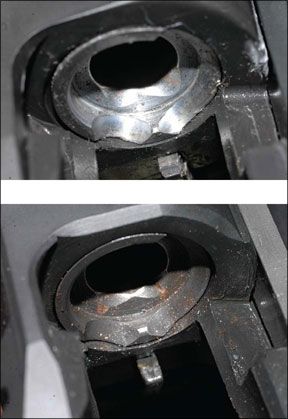
We got a chrome-lined barrel with the Fulton, $55 extra, and the barrel is a new one, not a new-old-service (NOS) G.I. Some time ago all the NOS surplus barrels, like the Winchester on our M14S, ran out, and newly manufactured ones are today about the only option. Fulton provides its own barrels, which it declares are NM quality. Fulton offers several types of barrel, and a mind-boggling host of parts and accessories for the rifle, all shown on the website (www.fulton-armory.com). The bayonet lug is a proper-looking item for those who live in states that permit them.
The investment-cast Fulton receiver is not the same as that on the Springfield. The contours and cuts are quite different. Fulton says it provides a NM flash hider with bayonet lug. The flash hider has wider slots than the Springfield’s. The Fulton had a 5.2-pound trigger pull, very clean, and the rifle came with a dry-fire device for practice. One possible justification for the cost of this rifle is the well-known Fulton practice of using extreme care combined with deep-seated knowledge of the rifle as it is being put together. Yes, we realize this is not always visible to the untrained eye, and it might not be worth it to you, but many of us here consider Fulton Armory’s reputation to be worth considering as having one of the better gunsmiths on military-type rifles in the business, Clint McKee, as the head honcho.
On the range we had zero problems, as expected, but of course we had no problems with any of the three rifles, as also might be expected. Our groups were all significantly smaller than what we got with the Springfield M1A. They were on a par with what we got from the custom M14S. But how much accuracy do you need on a non-competition rifle of this type? We like all we can get, as do you, we suspect. A scope could have made the groups a bit smaller, but we thought it was better to use the iron sights to see if there were any gross differences between the three test rifles. That testing proved the Fulton and the Fulton-custom to be superior in accuracy to the Springfield M1A.
Our Team Said: The Fulton had a precise feel the M1A didn’t have. It had better accuracy. It had a gorgeous, well fitted and finished stock. All those little things justified its cost to us. Bottom line, we could not fault the Fulton, but we did fault the M1A.
Springfield M1A 308 Win., $1739
Our test Springfield M1A came with three 10-round magazines, but no sling. However, the package included an owner’s manual, several brief publications about slam-fires, and the comprehensive Department of the Army Technical Manual on the “7.62 mm Rifle M14.” One of the first things that caught our eye was the dark-stained walnut stock, which has always been, and still is, too fat for our taste. However, if it offends you, you can purchase a new stock with GI contour from Fulton Armory for about $150, and still have spent $850 less than the tab for the Fulton.
We thought this was a very good rifle, at what we consider to be a very good price. Like the barrel on the Fulton, the M1A’s barrel is newly made, as apparently are many of the parts. The barrel and chamber are chrome lined, just like on the other two rifles. You can buy just as many accessories for this one as for any other M14 type. With the M1A you get an investment-cast receiver, but Springfield has sold a whole lot of M1As with a great success record. We can’t provide numbers as to how long any rifle will hold up, but our test inspection showed this to be a well-made and well-fitted rifle. However, when we worked the bolt vigorously on the Springfield, we noted it appeared to rattle a bit more than those of the Fulton and custom M14S, but we were unable to measure this. The plastic forend or barrel cover of the Springfield was a bit tighter than the Fulton’s, if that means anything. Both rifles had stripper-clip loading slots above the magazine well. The one on the custom rifle had been removed for the Brookfield mount, and was not replaced when the mount was removed. The result was a larger, more accessible opening in the custom rifle than in the other two.
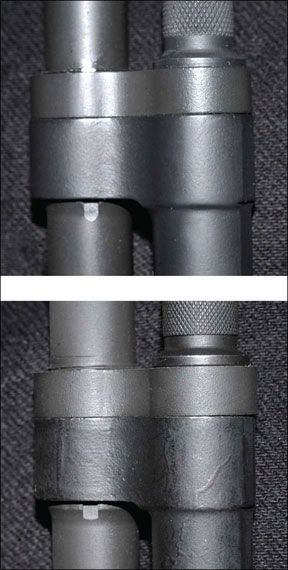
We liked the Springfield’s trigger. It had a 5.3-pound, very clean pull. Iron-sight accuracy was not quite as good as that of the other two rifles, but good enough for most uses. We had lots of trouble adjusting the rear sight to get our hits centered, and in fact were unable to rotate the windage knob in the forward direction unless we pressed on the elevation knob on the other side. We’re not sure the sight assembly was put together entirely correctly. We were able to make it work, and it held its adjustments, but the elevation clicks always seemed vague, and the windage was extremely stiff. By comparison, the adjustment knobs on the other two rifles, both set up by Fulton, were much more positive and precise, and very easy to use.
All functions operated perfectly, but we did notice an anomaly after all our shooting. The Springfield had acquired small bits of brass in the breech area of the action. Neither of the other two rifles had any at all. We don’t know the reason for all the bits of brass, but something is shaving the rounds as they go into or come out of the chamber. In a later specific test, the Springfield showed lots of brass particles after only five rounds, while the Fulton remained completely clean after ten. Little things like this did not help to inspire confidence in the M1A.
Our Team Said: There is no doubt the M1A was not as accurate as the other two. However, it might provide sufficient accuracy to you, for your specific needs. Most of our test crew declared we’d go for the better accuracy, tighter fitting, better wood, and precise feel of the Fulton, even if it cost $1000 more. The average shooter doesn’t buy too many rifles like this, and if you need one, we thought it might as well be the best example you can afford. But with that in mind, we declare you won’t be unarmed if you can only pop for the Springfield. You might be in for a bit of cleaning up work to eliminate the brass shaving, or maybe some tweaking for accuracy, but stuff like that is part of the fun of rifle ownership. We really loved the Fulton, but we think any shooter will really like the Springfield.



